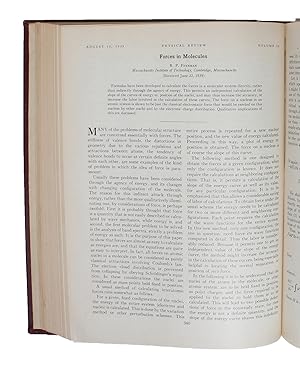Beschreibung
[Lancaster], American Institute of Physics, 1939. Royal8vo. Bound in contemporary full red cloth with gilt lettering to spine. Entire volume of "The Physical Review", Volume 56, Second Series, July 1 - December 15, 1939. "Development Department" in small gilt lettering to lower part of spine. A very fine and clean copy. [Feynman:] Pp. 340-43. [Bohr & Wheeler:] Pp. 426-50. [Oppenheimer & Snyder:] Pp. 455-59. [Entire volume: X, 1264 pp.]. First printing of three landmark papers, all of seminal importance in history of physics: Feynman's undergraduate thesis at MIT, the intricacies of the fission process, the groundwork for atomic and hydrogen bombs and the forgotten birth of black holes: The first theoretical description of a black hole, the production of a singularity when a sufficiently large neutron star collapses.First printing of "FORCES IN MOLECULES" - know known as Feynman-Hellmann theorem - is Feynman's undergraduate thesis at MIT, published when he was just twenty-one, which helped to establish his name in the world of physics. "This work treated the problem of molecular forces from a thoroughly quantum-mechanical point of view, arriving at a simple means of calculating the energy of a molecular system that continues to guide quantum chemists." (DSB). "As Feynman conceived the structure of molecules, forces were the natural ingredients. He saw springlike bonds with varying stiffness, atoms attracting and repelling one another. The usual energy-accounting methods seemed secondhand and euphemistic: [He demonstrated that] the force on an atom's nucleus is no more or less than the electrical force from the surrounding field of charged electrons-the electrostatic force. Once the distribution of charge has been calculated quantum mechanically, then from that point forward quantum mechanics disappears from the picture. The problem becomes classical" the nuclei can be treated as static points of mass and charge. Feynman's approach applies to all chemical bonds" (Gleick, The Life and Science of Richard Feynman, P. 54).Oppenheimer and Snyder's "ON CONTINUED GRAVITATIONAL CONTRACTION" constitute the very first theoretical prediction of a singularity when a sufficiently large neutron star collapses. This phenomenon was later to be coined as a black hole. "Had J. Robert Oppenheimer not led the US effort to build the atomic bomb, he might still have been remembered for figuring out how a black hole could form." (American Physical Society). The paper has by several physics historians been described as the forgotten birth of black holes. "Oppenheimer and his graduate student George Volkoff presented the first analysis of the formation of a neutron star in a 1939 Physical Review paper titled, "On Massive Neutron Stars". Oppenheimer wondered what would happen to a very massive neutron star. The Schwartzschild analysis of General Relativity has a theoretical limit, called the "Schwartzschild limit", when the ratio of mass-to-radius of a star is 236,000 times greater than the ratio for our sun. When this limit is exceeded, the Schwartzschild analysis does not yield a solution. Oppenheimer believed that a neutron star could have sufficient mass to exceed this limit. What would happen to it? Oppenheimer and his graduate student Hartland Snyder applied General Relativity theory to a star with sufficient mass and density to exceed the Schwartzschild limit. The Schwartzschild analysis assumed that the size of the star stays constant with time. Oppenheimer and Snyder found that they could achieve a real solution from General Relativity when the Schwartzschild limit is exceeded by assuming that the diameter of the star decreases with time. They presented their analysis in a 1939 Physical Review paper, titled, "On Continual Gravitational Contraction," which concluded with: "When all thermonuclear sources of energy are exhausted, a sufficiently heavy star will collapse. Unless fission due to rotation, the radiation of mass, or the blowing off of ma. Bestandsnummer des Verkäufers 46900
Verkäufer kontaktieren
Diesen Artikel melden
![]()




